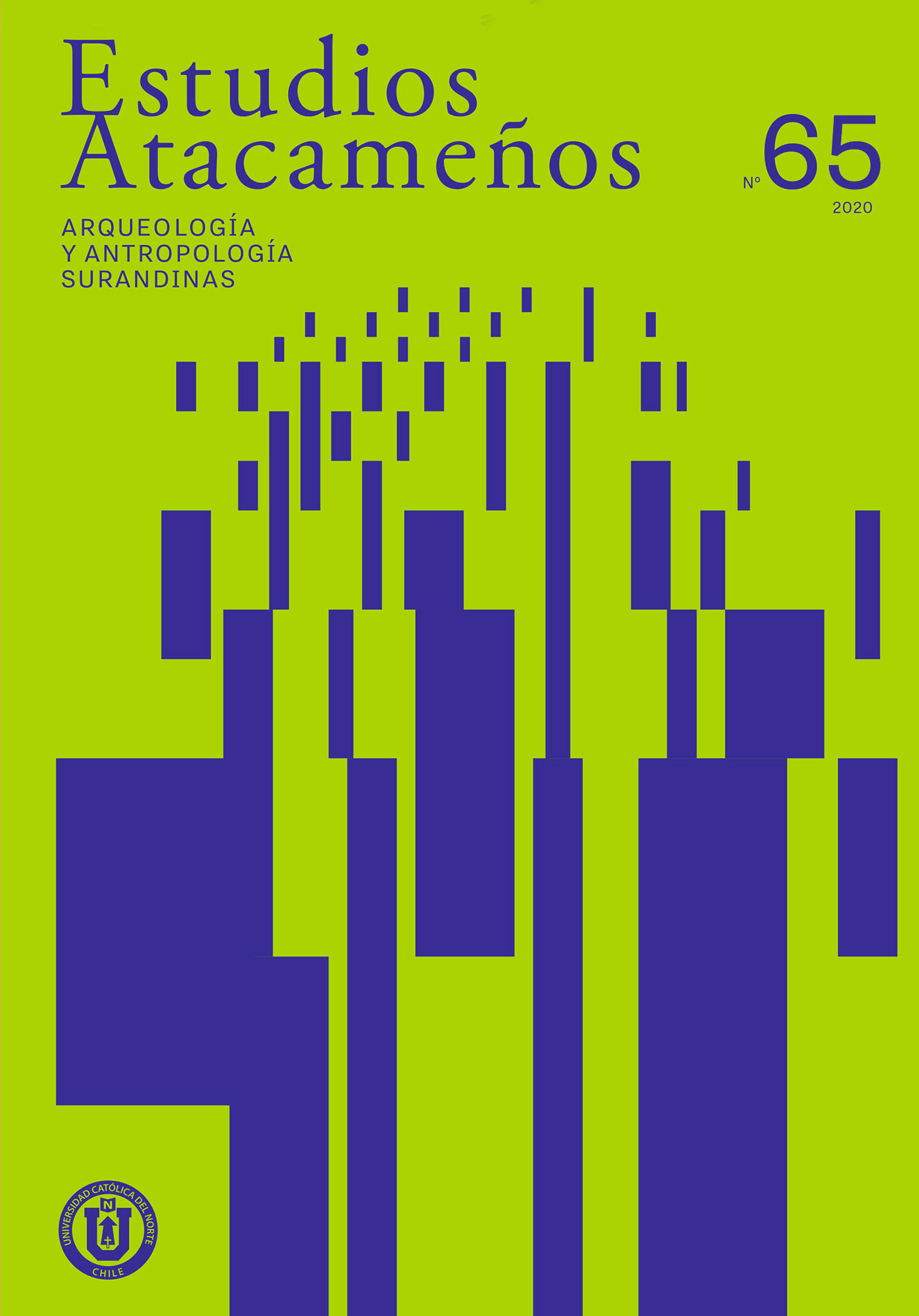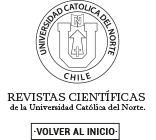Lithic taphonomy of the Quebrada de Quereo site
Addressing the problem of anthropogenic ambiguity in Late Pleistocene assemblages
DOI:
https://doi.org/10.22199/issn.0718-1043-2020-0026Keywords:
lithic taphonomy, semiarid north, late Pleistocene, pseudo-artifacts, anthropogenic ambiguityAbstract
This paper aims to develop an analytical proposal for dealing with ambiguity in lithic material of late Pleistocene contexts in alluvial locations. We focus our study on the Quebrada de Quereo site (13480-13070 cal BP) located in the coast of Northern Semiarid Chile. To build a comparative analog, different combinations of taphonomic and technological variables are explored in an assemblage of natural origin from a nearby ravine that mimics lithic knapping attributes. This same set of variables was tested on the anthropogenic lithic assemblage of the Quebrada Santa Julia site (12990-12730 cal BP). This procedure allowed us developing an analytic system centered on the characteristics of chipped edges to weigh taphonomic and technological attributes and their natural production in torrential ravine contexts. By applying this scheme to a sample of the lithic material of Quebrada de Quereo, we discuss which pieces are most likely to be considered as lithic artifacts. We conclude that most of the Quebrada de Quereo lithic assemblage may be explained as produced by natural causes, thus those pieces should be considered pseudo-artifacts.
Downloads
References
Andrefsky, W. (2005). Lithics: macroscopic approaches to analysis. New York: Cambridge University Press.
Andrefsky, W. (2013). Fingerprinting flake production and damage processes: Toward identifying human artifact characteristics. En Graf, K., Ketron, C. y Waters, M. (Eds.). Paleoamerican Odyssey (pp. 415-428). Texas: Center for the Study of the First Americans, Texas A&M University.
Ascher, R. y Ascher, M. (1965). Recognizing the emergence of man. Science, 147, 3655.
Balirán, C. (2014). Trampling, taphonomy, and experiments with lithic artifacts in the southeastern Baguales Range (Santa Cruz, Argentina). Intersecciones en Antropología, Special Issue, 1, 85-95.
Bate, F. (1971). Material lítico: metodología de clasificación. Noticiario Mensual del Museo Nacional de Historia Natural, 181?182, 3?24.
Boëda, E., Clemente-Conte, I., Fontugne, M., Lahaye, C., Pino, M., Felice, G. … Douville, E. (2014). A new late Pleistocene archaeological sequence in South America: The Vale da Pedra Furada (Piauí, Brazil). Antiquity, 88, 927-41.
Borrazzo, K. (2006). Tafonomía lítica en dunas: una propuesta para el análisis de los artefactos líticos. Intersecciones en Antropología, 7, 247? 261.
Borrazzo, K. (2011). Tafonomía lítica y pseudoartefactos: el caso de la península El Páramo (Tierra del Fuego, Argentina). Intersecciones en Antropología, 12, 155-167.
Borrazzo, K. (2016). Lithic taphonomy in desert environments: Contributions from Fuego-Patagonia (Southern South America). Quaternary International, 422, 19-28.
Borrero, L. (2016). Ambiguity and debates on the early peopling of South America. PaleoAmerica. DOI: 10.1080/20555563.2015.1136498
Burroni, D., Donahue, R. y Pollard, A. (2002). The surface alteration features of flint artefacts as a record of environmental processes. Journal of Archaeological Science, 29, 1277-1287.
Cecioni, G. y Westermann, C. (1968). The Triassic?Jurassic marine transition of coastal central Chile. Pacific Geology, 1, 41?75.
Cotterell, B. y Kaaminga, J. (1987). The formation of flakes. American Antiquity, 52, 675–708.
De la Peña, P. y Witelson, D. (2018). Trampling vs. retouch in a lithic assemblage: a case study from a Middle Stone Age site, Steenbokfontein 9KR (Limpopo, South Africa). Journal of Field Archaeology, 43(7), 522-537.
Dorn, R. (1998). Rock coatings. Amsterdam: Elsevier.
Ellen R. y Muthana A. (2010). Classifying ‘eoliths’: how cultural cognition featured in arguments surrounding claims for the earliest human artefacts as these developed between 1880 and 1900. Journal of Cognition and Culture, 10, 341-375.
Eren, M., Boehm A., Morgan B., Anderson R., y Andrews B. (2011). Flake stone taphonomy: a controlled experimental study of the effects of sediment consolidation on flake edge morphology. Journal of Taphonomy, 9, 201-17.
Fariña, R., Tambusso, A., Varela, L., Czerwonogora, A., Di Giacomo, M., Musso, M. … Gascue, A. (2014a). Arroyo del Vizcaíno, Uruguay: A fossil-rich 30-ka-old megafaunal locality with cut-marked bones. Proceedings of the Royal Society B, 281, 2013-2211.
Fariña R., Tambusso, P., Varela, L., Di Giacomo, M., Musso, M., Gascue, A. … Bracco, R. (2014b). Among others, cut-marks are archaeological evidence: reply to ‘Archaeological evidences are still missing: a comment on Fariña et al. Arroyo del Vizcaíno Site, Uruguay’ by Suárez et al. Proceedings of the Royal Society B, 281, 20141637. DOI: 10.1098/rspb.2014.1637.
Fiedel, S. (2017). Did monkeys make the pre-Clovis pebble tools of Northeastern Brazil? PaleoAmerica, 3(1), 6-12.
Garvey, R. y Mena, F. (2016). Confronting complexities of artifact–geofact debates: re-analysis of a coarse volcanic rock assemblage from Chilean Patagonia. Lithic Technology, 41(2), 114-129. DOI: 10.1080/01977261.2016.1152023.
Gifford-González, D., Damrosch, D., Damrosch, D., Pryor, J. y Thunen, R. (1985). The third dimension in site structure: an experiment in trampling and vertical dispersal. American Antiquity, 50, 803-818.
Gillespie, J., Tupakka, S. y Cluney, C. (2004). Distinguishing between naturally and culturally flaked cobbles: a test case from Alberta, Canada. Geoarchaeology: An International Journal, 19, 615-633.
Goldberg, P. y Macphail, R. (2006). Practical and theoretical geoarchaeology. Malden, Oxford, Carlton, UK: Blackwell Publishing.
Goldich, S. (1938). A study in rock-weathering. The Journal of Geology, 46, 17-58.
Guidon, N. (2008). Pedra Furada: A revision. Fundhamentos VII.
Guidon, N. y Arnaud, B. (1991). The chronology of the New World: two faces of one reality. World Archaeology, 23, 167-178.
Guidon, N., Pessis, A., Parenti, F., Fontugue, M. y Guérin, C. (1996). Nature and age of the deposits in Pedra Furada, Brazil: reply to Meltzer, Adovasio y Dillehay. Antiquity, 70, 408-21.
Haynes, C. (1973). The Calico site: artifacts or geofacts? Science, 181, 305-310.
Hiscock, P. (1985). The need for a taphonomic perspective in stone artefact analysis. Queensland Archaeological Research, 2, 82-95.
Hosfield, R. y Chambers, C. (2003). Flake modifications during fluvial transportation: three cautionary tales. Lithics: The Newsletter of the Lithic Studies Society, 24, 57-65.
Inizan, M., Reduron-Ballinger, M., Roche, H. y Tixier, J. (1999). Technologie de la pierre taillée. Meudon, Francia: CREP.
Jackson, D., Méndez, C. y De Souza, P. (2004). Poblamiento Paleoindio en el Norte-Centro de Chile: evidencias, problemas y perspectivas de estudio. Complutum, 15, 165-176.
Jackson, D., Méndez, C., Seguel, R., Maldonado, A. y Vargas, G. (2007). Initial occupation of the Pacific Coast of Chile during late Pleistocene times. Current Anthropology, 48(5), 725-731.
Jackson, D., Méndez, C., Núñez, L. y Jackson, D. (2011). Procesamiento de fauna extinta durante la transición Pleistoceno-Holoceno en el centro-norte de Chile. Boletín de Arqueología PUCP, 15, 315-336.
López, P. (2007). Tafonomía de los mamíferos extintos del pleistoceno tardío de la costa meridional del semiárido de Chile (IV región – 32° latitudes): alcances culturales y paleoecológicos. Chungara. Revista de Antropología Chilena, 39(1), 69-86.
López, P., Labarca, R. y Núñez, L. (2004). Nivel Quereo I. Una discusión acerca del poblamiento temprano en la Provincia del Choapa. Werken, 5, 15?20.
Lopinot N. y Ray, J. (2007). Trampling experiments in the search for the earliest Americans. American Antiquity, 72(4), 771-782.
Lubinski P., Terry, K., y McCutcheon, P. (2014). Comparative methods for distinguishing flakes from geofacts: a case study from the Wenas Creek Mammoth site. Journal of Archaeological Science, 52, 308-320.
Luebert, F. y Pliscoff, P. (2006). Sinopsis bioclimática y vegetacional de Chile. Santiago: Universitaria.
Luetdke, B. (1986). An experiment in natural fracture. Lithic Technology, 15, 55-60.
Maldonado, A., Méndez, C., Ugalde, P., Jackson, D., Seguel, R. y Latorre, C. (2010). Early Holocene climate change and human occupation along the semiarid coast of north?central Chile. Journal of Quaternary Science, 25(6), 985-988.
McBrearty, S., Bishop, L., Plummer, T., Dewar, R. y Conard N. (1998). Tools underfoot: human trampling as an agent of lithic artifact edge modification. American Antiquity, 63, 108-129.
McPherron S., Braun, D., Dogandzic T., Archer, W., Desta, D. y Lin, S. (2014). An experimental assessment of the influences on edge damage to lithic artifacts: a consideration of edge angle, substrate grain size, raw material properties, and exposed face. Journal of Archaeological Science, 49, 70-82.
Méndez, C. (2004). Una sociedad de cazadores recolectores en movimiento durante la primera mitad del Holoceno tardío en Los Vilos. Tesis para optar al grado de Magíster en Antropología, mención Arqueología. Universidad Católica del Norte, Chile.
Méndez, C. (2010). Tecnología lítica en el poblamiento pleistoceno terminal del centro de Chile. Organización, gestos y saberes. Tesis para optar al grado de Doctor en Antropología, mención Arqueología. Universidad Católica del Norte, Chile.
Méndez, C. (2015). Los primeros andinos. Tecnología lítica de los habitantes de Chile trece mil años atrás. Lima: Fondo Editorial de la Pontificia Universidad Católica del Perú, Colección Estudios Andinos.
Méndez C. y Jackson, D. (2015). Terminal Pleistocene lithic technology and use of space in Central Chile. Chungara. Revista de Antropología Chilena, 47(1), 53-65.
Méndez, C., Jackson, D., y Seguel, R. (2004). Narrowing the spatial range of megafaunal distributions on the Semiarid coast of Chile. Current Research in the Pleistocene, 21, 109?110.
Méndez, C., Jackson, D., López, P. y Jackson, D. (2005?6). Tan lejos, tan cerca: de sitios paleoindios y depósitos secundarios. Intervenciones arqueológicas en el nivel II del yacimiento pleistocénico “Las Monedas”. Revista Chilena de Antropología, 18, 135?153.
Nielsen, A. (1991). Trampling the archaeological record: an experimental study. American Antiquity, 56, 483-503.
Núñez, L., Varela, J. y Casamiquela, R. (1983). Ocupación Paleoindio en Quereo. Antofagasta: Universidad del Norte, Chile.
Núñez, L., Varela, J. y Casamiquela, R. (1987). Ocupación paleoindia en el centro norte de Chile: adaptación circunlacustre en las tierras bajas. Estudios Atacameños, 8, 142?185.
Núñez, L., Varela, J., Casamiquela, R. y Villagrán, C. (1994). Reconstrucción multidisciplinaria de la ocupación prehistórica de Quereo, centro de Chile. Latin American Antiquity, 5(2), 99?118.
Oakley, K. (1968). Man the tool-maker. Chicago, IL: The University of Chicago Press.
O’Connor, A. (2007). Finding time for the old Stone Age. A history of palaeolithic archaeology and quaternary geology in Britain, 1860–1960. Oxford, UK: Oxford University Press.
Ortega, C., Vargas, G., Rutllant, J., Jackson, D., Méndez, C. (2012). Major hydrological regime change along the semiarid western coast of South America during the early Holocene. Quaternary Research, 78, 513-527.
Patterson, L. (1983). Criteria for determining the attributes of man-made lithics. Journal of Field Archaeology, 10(3), 297-307.
Peacock, E. (1991). Distinguishing between artifacts and geofacts: A test case from Eastern England. Journal of Field Archaeology, 18(3), 345-361.
Petraglia, M. y Potts, R. (1994). Water flow and the formation of Early Pleistocene artifact sites in Olduvai Gorge, Tanzania. Journal of Anthropological Archaeology, 13, 228-254.
Prentiss, A., Walsh, M., Barnett, K., Murphy, M-M. y Kuenstle, J. (2015). The coarse volcanic rock industry at the Rio Ibañez 6 west site, Chilean Patagonia. Lithic Technology, 40(2), 112-127
Proffitt T., Luncz, L., Falótico, T., Ottoni, E., De la Torre, I. y Haslam, M. (2016). Wild monkeys flake stone tools. Nature, 539, 85-88.
Rivano, S. y Sepúlveda, P. (1991). Hoja Illapel. Región de Coquimbo. Santiago: Sernageomin.
Schiffer, M. (1983). Toward the identification of formation processes. American Antiquity, 48(4), 675-706.
Schulz, H-P. (2010). The Susiluola cave site in western Finland. Evidence of the northernmost Middle palaeolithic settlement in Europe. Studia Archeologiczne, XLI.
Stein, J. (1987). Deposits for archaeologists. En Schiffer, M. (Ed.). Advances in Archaeological Method and Theory (pp. 337?395). San Diego, CA: Academic Press.
Suárez, R., Borrero, L., Borrazzo, K., Ubilla, M., Martínez, S. y Perea, D. (2014). Archaeological evidences are still missing: a comment on Fariña et al. Arroyo del Vizcaíno Site, Uruguay. Proceedings of the Royal Society B, 281, 20140449.
Ugalde, P., Santoro, C., Gayo, E., Latorre, C., Maldonado, S., De Pol-Holz, R. y Jackson, D. (2015). How do surficial lithic assemblages weather in arid environments? A case study from the Atacama Desert, Northern Chile. Geoarchaeology, 30, 352-368.
Varela, J. (1981). Geología del Cuaternario del área de Los Vilos – Ensenada El Negro (IV Región) y su relación con la existencia del bosque “relicto” de Quebrada Quereo. Comunicaciones, 33, 17?30.
Vicente, J. (1974). Example de “volcanisme initial euliminare”. Les complexes albitophyriques neotriassiques et Jurassiques du secteur côtier des Andes Meridionales (32°-33° Lat. Sud). En González, O. (Ed.). Simposium on Andean Volcanology and Chemical of the Earth’s Interior, 267-329. Santiago.
Warren, S. H. (1905). On the origin of ‘eolithic’ flints by natural causes, especially by the foundering of drifts. Man, 5, 337-364.
Weitzel, C., Borrazzo, K., Ceraso, A. y Balirán, C. (2014). Trampling fragmentation potential of lithic artifacts: an experimental approach. Intersecciones en Antropología, Special Issue, 1, 97-110.
Whittaker, J. (1994). Flintknapping: Making and understanding stone tools. Texas, TX: University of Texas Press.
Downloads
Published
Issue
Section
License
Copyright (c) 2020 Javier Ignacio Carranza Elola, César Méndez

This work is licensed under a Creative Commons Attribution 4.0 International License.

All works published in Revista Estudios Atacameños (ISSN on line:0718-1043) Revista Estudios Atacameños Creative Commons International 4.0 attribution (CC BY 4.0) licence.
Authors remain the owners of their work and may republish their articles elsewhere without having to request permission, as long as they indicate that the work was originally published in Revista Estudios Atacameños (ISSN on liine:0718-1043).












